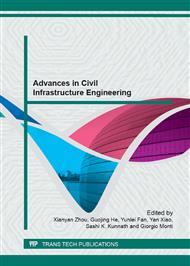p.394
p.399
p.404
p.411
p.417
p.423
p.429
p.434
p.444
The Influence of Mineral Admixtures on the Wear-Resisting Property of Recycled Aggregate Concrete
Abstract:
It was tested the strength and wear value of recycled aggregate concrete mixing fly ash, slag, silica fume and double-mixture or three-mixture in deferent age. The results show that the wear value of recycled aggregate concrete mixing 30% fly ash is more than reference concrete at 3days, but can improve final wear-resisting property significantly. The wear value of recycled aggregate concrete mixing 30% double-mixture of fly ash and silica fume is much lower than reference concrete at 3days, and improve early wear-resisting property significantly. The flexural strength of the concrete is 4.26MPa at 3days, which can satisfy the traffic requirement. The wear value of recycled aggregate concrete mixing 30% three-mixture of fly ash, slag and silica fume is lower than reference concrete at 3days, but the declining rate is not significant. It investigates mechanics of double-mixture technique which improves wear-resisting property at the same time.
Info:
Periodical:
Pages:
417-422
Citation:
Online since:
January 2013
Authors:
Price:
Сopyright:
© 2013 Trans Tech Publications Ltd. All Rights Reserved
Share:
Citation:


